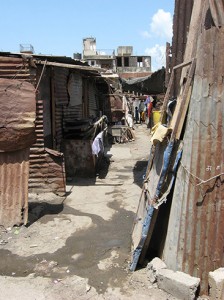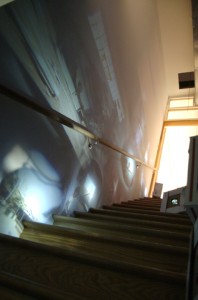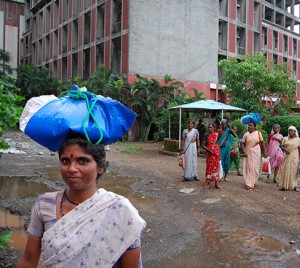Mumbai in the past twenty years has gone through a prodigious economic boom, bringing an influx of migrant workers from the rest of the country to perform labor and service-industry work. It is India’s largest city at 13.5 million, and it suffers from the usual developing-city problems like poverty, lack of social services and clean water, etc. Mumbai Mobile Crèches has been the only NGO specifically supporting the health, education and safety of children of construction laborers. And now for the Philadelphia/Mumbia connection: — a “guerilla design” project of the Philadelphia non-profit International Design Clinic, headed by Scott Shall of Temple University’s Architecture program. AIA, the Center for Architecture, was the host of a recent talk about the project. Here’s my report.

In August 2008, Scott Shall organized a 40-person team in collaboration with the Temple Study Abroad Program and D.Y. Patil University to work in crèches (on-site temporary housing for construction workers) scattered across Mumbai. The group worked alongside the NGO Mumbai Mobile Crèches, a non-profit that provides schooling and health programs for the crèches’ children. The students’ goal was to utilize their knowledge as creative thinkers to engage in “guerrilla design.” Inventing new, cheap architectural and design strategies allowed them to attenuate the effects of the temporary living settlements for the crèches’ inhabitants.
The AIA show accompanying Shall’s talk was in the large space behind the AIA bookstore. The room was dark, with small sources of light glowing from inside small USPS Priority Mail cardboard boxes which were stacked on their sides and arranged around the room. Upon closer inspection, each box held an individual slide photo, illuminated by a keychain LED. A double convex glass lens was mounted on top, and acted as a magnifying device. Each image was taken by one of 210 Mumbai children, who were given cameras by members of Shall’s team and told to photograph their homes and lives. (See more photos at IDC’s flickr site.)

The installation/opening party was very interactive. Perhaps this was due to the nature of the space: one tends to feel less self-conscious in a dark room. People were holding the projection boxes in front of them like pregnant stomachs, moving in front of the screen, causing the image to grow and shrink. A DJ was on the side of the main room playing electronic music, next to a video projector which showed a backwards-projected rickshaw ride, and children playing in small colorful triangular collapsible structures which turned out to be child-sized freespaces, designed by project members.
Images and diagrams sat on removable mounts, illuminated by small dangling maglites. The mounted images described a history of IDC’s projects since 2006. A photocopier next to the display encouraged the viewer to take the diagrams and copy them. It is in Shall’s hopes that these projects will be taken up by others, to be “hacked” and improved upon. The diagrams followed an Ikea-like format, with the universal no-language and numbers, only line images.

One particularly intersting project was the 99-rupee (2 dollar) water filter. Using a sweater bag, a recycled tarp and four grommets, the team created a bag for purifying water that utilizes solar radiation to eliminate 99% of waterborne pathogens after 6-8 hours. Access to clean water in Mumbai is a serious problem. According to a 2003 study, the water in much of Mumbai is septic. The people of Mumbai are literally drinking and eating shit.
At six weeks, the students’ time in Mumbai was temporary. The homes of the migrants on the construction sites are also temporary, lasting about two years before construction completion. The migrant workers in these crèches are not looking for, or in need of, permanent structures such as schools; they need ideas that allow them to make effective improvements in their temporary communities. One thing that should be noted is that these crèches are not slums. One can argue that they are worse. Slums by comparison are permanent neighborhoods. 64% of Mumbai’s population lives in a slum (middle-class slums also exist).
Stephanie Dejarnette, who previously earned her BFA in printmaking at Temple commented that IDC changed her perspective of what she was capable of, as though she no longer had artistic limitations, “I’m not a chemist. I never thought I’d be helping to design a water filtration system.”
Shall mentioned, “We were given a grant to show what we had done in Philadelphia. But for what public? We didn’t know if it should even be in a gallery space,” as though he was aware that people/the students themselves may not necessarily call their project “art”. I asked him if students realign their artistic course towards sustainable efforts after participating in an IDC project. He responded, “Many begin to lean in that way.”
Although the show at AIA was on the oblique side, the perspective that Shall (certainly an aptronym) was encouraging in his students seemed invaluable. He brings young architects, designers, artists, etc to places where they can channel their creative thinking towards a common goal. Perhaps this is where the creative people go in times of recession, as predicted by articles in the past three months like The Boom Is Over. Long Live the Art! by Holland Cotter, New York Times (February 12, 2009) and End the University as We Know It by Mark Taylor, Op-Ed Columnist New York Times (April 26, 2009). These articles have been sent to me by, not surprisingly, many of my artist friends. It’s as though our economic recession has made us wish to justify our art-making, by tying it in with other disciplines and putting our aim towards less narrow objectives. Taylor writes, “through the intersection of multiple perspectives and approaches, new theoretical insights will develop and unexpected practical solutions will emerge.” The idealism encouraged by Shall certainly falls in line with this perspective, and seems like an entirely positive thing.





